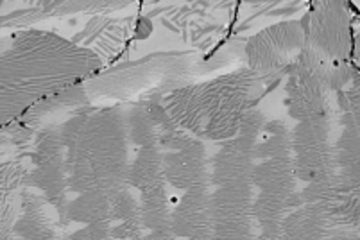All genres
41.
Talk
Arthropod cuticle: A biological multi-functional composite used as template for nano-to-macro-scale hierarchical modeling. Advanced Materials 2013, Zhenjiang, China (2013)
42.
Talk
Ab initio study of thermodynamic, electronic, magnetic, structural, and elastic properties of Ni4N allotropes. DPG Frühjahrstagung, Regensburg, Germany (2013)
43.
Talk
On the Role of Mg Atoms in Calcite Crystals: An Ab Initio Study. EURO Bio-inspired Materials, International School and Conference on Biological Materials Science, Potsdam, Germany (2012)
44.
Talk
Arthropod cuticle: A biological multi-functional composite used as template for nano-to-macro-scale hierarchical modelling. EURO Bio-inspired Materials, International School and Conference on Biological Materials Science, Potsdam, Germany (2012)
45.
Talk
Arthropod cuticle: A biological multi-functional composite used as template for nano-to-macro-scale hierarchical modelling. Euro BioMat, Jena, Germany (2011)
46.
Talk
Arthropod cuticle: A biological multi-functional composite used as template for nano-to-macro-scale hierarchical modelling. THERMEC 2011, Quebec, Canada (2011)
47.
Talk
Using ab-initio based multiscale models and experiments for alloy design. Colloquium Lecture, Institute for High Performance Computing, Agency of Science, Technology and Research, Singapore City, Singapore (2010)
48.
Talk
Arthropod cuticle: A biological multi-functional composite used as template for nano-to-macro-scale hierarchical modeling. Multiscale Materials Modeling, Freiburg, Germany (2010)
49.
Talk
Combining ab-initio based multiscale models and experiments for structural alloy design. Colloquium Lecture, Australian Microscopy & Microanalysis Research Facility, The University of Sydney, Sydney, Australia (2010)
50.
Talk
Ab initio based multi-scale approaches to the elasticity of polycrystals. ICAMS Scientific Retreat, Akademie Biggsee, Attendorn, Germany (2010)
51.
Talk
Ab initio based study of multi-scale elastic properties of hierarchical biocomposites. Seminar talk at Masaryk University, Brno, Czech Republic (2010)
52.
Talk
Arthropod Cuticle: A Biological Multifunctional Composite Used As Template for Multidisciplinary Nano-To-Macro-Scale Hierarchical Modeling. 139th Annual Meeting of the Minerals, Metals and Materials Society (TMS), Seattle, WA, USA (2010)
53.
Talk
Theory-guided Design of Bone-matched Ti-based Multi-phase Biomaterials. Materials Research Society (MRS) meeting, Boston, MA, USA (2009)
54.
Talk
Multi-physical alloy approaches to solid solution strengthening of Al. 1st International Conference on Material Modelling, Dortmund, Germany (2009)
55.
Talk
Hierarchical modeling of the elastic properties of lobster cuticle via first principles calculations and mean-field homogenization. 1st International Conference on Material Modeling, Dortmund, Germany (2009)
56.
Talk
Investigation of solid solution strengthening by density functional theory. EUROMAT 2009, Glasgow, Scotland, UK (2009)
57.
Talk
Multi-Scale Hierarchical Modeling of the Mechanical Properties of Lobster Cuticle. EUROMAT 2009, Glasgow, UK (2009)
58.
Talk
Investigation of solid solution strengthening by density functional theory. 11-th National Congress on Theoretical and Applied Mechanics, Borovets, Bulgaria (2009)
59.
Talk
Multi-physical alloy approaches to solid solution strengthening of Al. 15th International Conference of Strength of Materials, Dresden, Germany (2009)
60.
Talk
Crystal plasticity finite element study on small scale plasticity of micropillars. 15th International Conference on the Strength of Materials (ICSMA-15), Dresden, Germany (2009)











